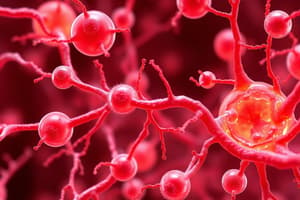Podcast
Questions and Answers
Which of the following is NOT a property of life?
Which of the following is NOT a property of life?
- Spontaneous generation (correct)
- Order
- Response to the environment
- Energy processing
What is the process by which organisms adapt to their environment over many generations?
What is the process by which organisms adapt to their environment over many generations?
- Reproduction
- Evolutionary adaptation (correct)
- Growth and development
- Regulation
Which of the following levels of biological organization includes both living and non-living components?
Which of the following levels of biological organization includes both living and non-living components?
- Community
- Ecosystem (correct)
- Biosphere
- Population
What is the highest level of biological organization mentioned in the text?
What is the highest level of biological organization mentioned in the text?
Which of the following is controlled by an organism's inherited DNA?
Which of the following is controlled by an organism's inherited DNA?
What is the study of life at different levels, from molecules to the entire living planet, called?
What is the study of life at different levels, from molecules to the entire living planet, called?
What process must a cell undergo during cell division?
What process must a cell undergo during cell division?
Which molecules are responsible for encoding information for building proteins?
Which molecules are responsible for encoding information for building proteins?
What is the process of converting information from a gene into a cellular product called?
What is the process of converting information from a gene into a cellular product called?
In the lens cells, what is the sequence through which the crystallin protein is produced?
In the lens cells, what is the sequence through which the crystallin protein is produced?
What type of energy is usually converted to chemical energy in living organisms?
What type of energy is usually converted to chemical energy in living organisms?
In an ecosystem, how does energy typically flow through the system?
In an ecosystem, how does energy typically flow through the system?
Which of the following best describes the emergent properties in biology?
Which of the following best describes the emergent properties in biology?
What is the underlying unity characteristic of all living organisms?
What is the underlying unity characteristic of all living organisms?
Which of the following best describes the correlation between structure and function in biology?
Which of the following best describes the correlation between structure and function in biology?
Which of the following is NOT a property associated with life?
Which of the following is NOT a property associated with life?
What is the primary focus of the study of evolution?
What is the primary focus of the study of evolution?
Which of the following is a primary goal of biodiversity studies?
Which of the following is a primary goal of biodiversity studies?
Flashcards are hidden until you start studying
Study Notes
Properties of Life
- Characteristics of life include growth, reproduction, response to stimuli, and homeostasis.
- Not all entities exhibit these properties; for example, viruses do not fulfill all criteria of a living organism.
Adaptation and Evolution
- Organisms undergo adaptation to their environment through the process of evolution over many generations.
- Evolution is driven by natural selection, where favorable traits become more common in successive generations.
Biological Organization
- Biological levels of organization include both living (biosphere, ecosystem) and non-living components (abiotic factors).
- The highest level of biological organization discussed is the biosphere, encompassing all ecosystems on Earth.
Genetic Inheritance
- An organism's inherited DNA controls various traits and biological functions.
- Genes are the functional units of heredity that dictate the characteristics of organisms.
Study of Life
- The study of life from molecular levels to the entire ecosystem is called biology.
- This field explores life through various scales and contexts.
Cell Division
- Cells undergo mitosis during cell division, leading to the replication of genetic material and division into daughter cells.
Molecular Encoding
- DNA molecules are responsible for encoding the information necessary for building proteins through sequences of nucleotides.
Gene Expression
- The process of converting a gene's information into a functional cellular product, often a protein, is referred to as gene expression.
Protein Production
- In lens cells, the production of crystallin protein follows the sequence of transcription (DNA to mRNA) and translation (mRNA to protein).
Energy Transformation
- Living organisms typically convert solar energy into chemical energy through photosynthesis.
Energy Flow in Ecosystems
- Energy in an ecosystem flows from producers (like plants) to consumers (like animals) and decomposers, adhering to the laws of thermodynamics.
Emergent Properties
- Emergent properties in biology refer to characteristics that arise from the arrangement and interaction of components, not evident in individual parts.
Unity of Life
- All living organisms share underlying unity, including cellular structure, biochemical pathways, and genetic codes, reflecting common ancestry.
Structure and Function
- The correlation between structure and function in biology means that the form of a biological structure is closely related to its role and function within an organism.
Focus of Evolutionary Study
- The primary focus of evolution is to understand the mechanisms driving the diversity of life and the adaptation of organisms to their environments.
Biodiversity Studies Goals
- A key goal of biodiversity studies is to assess and conserve the variety of life forms and their interactions within ecosystems for ecological balance.
Studying That Suits You
Use AI to generate personalized quizzes and flashcards to suit your learning preferences.




